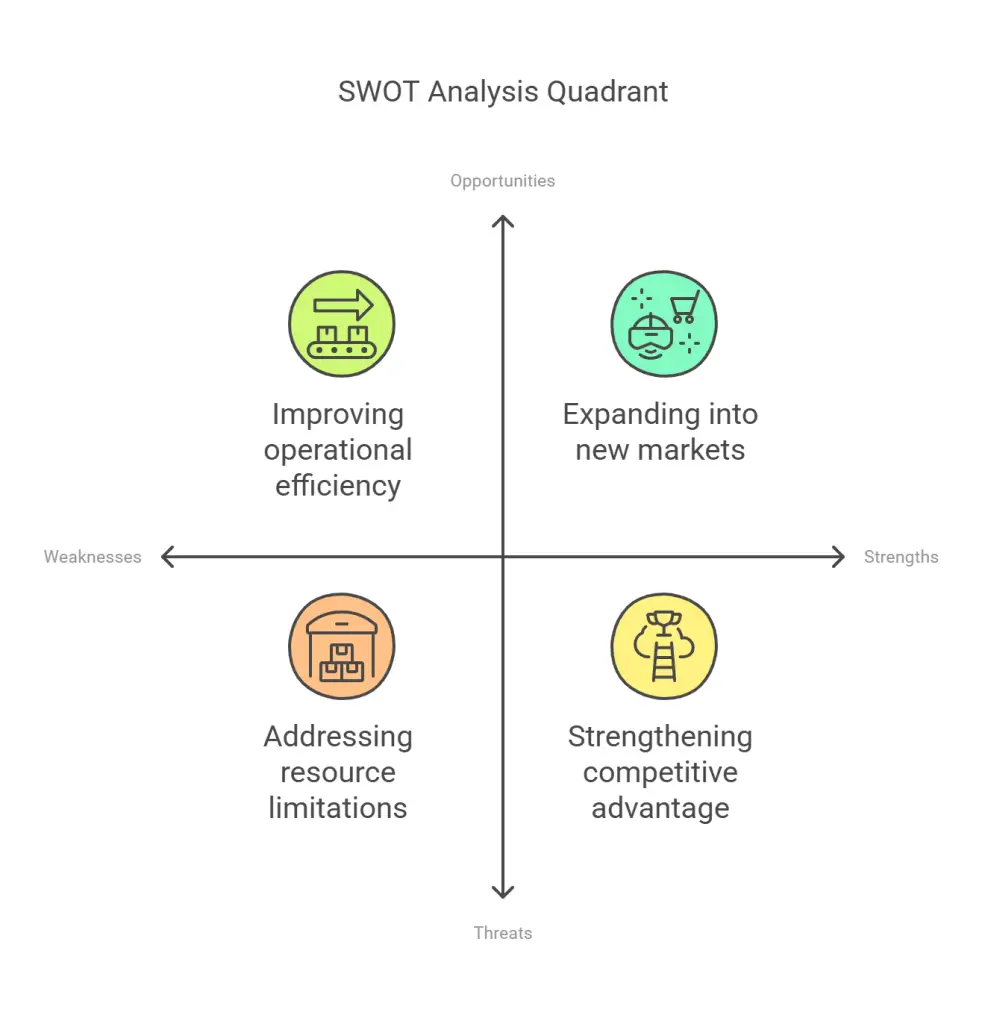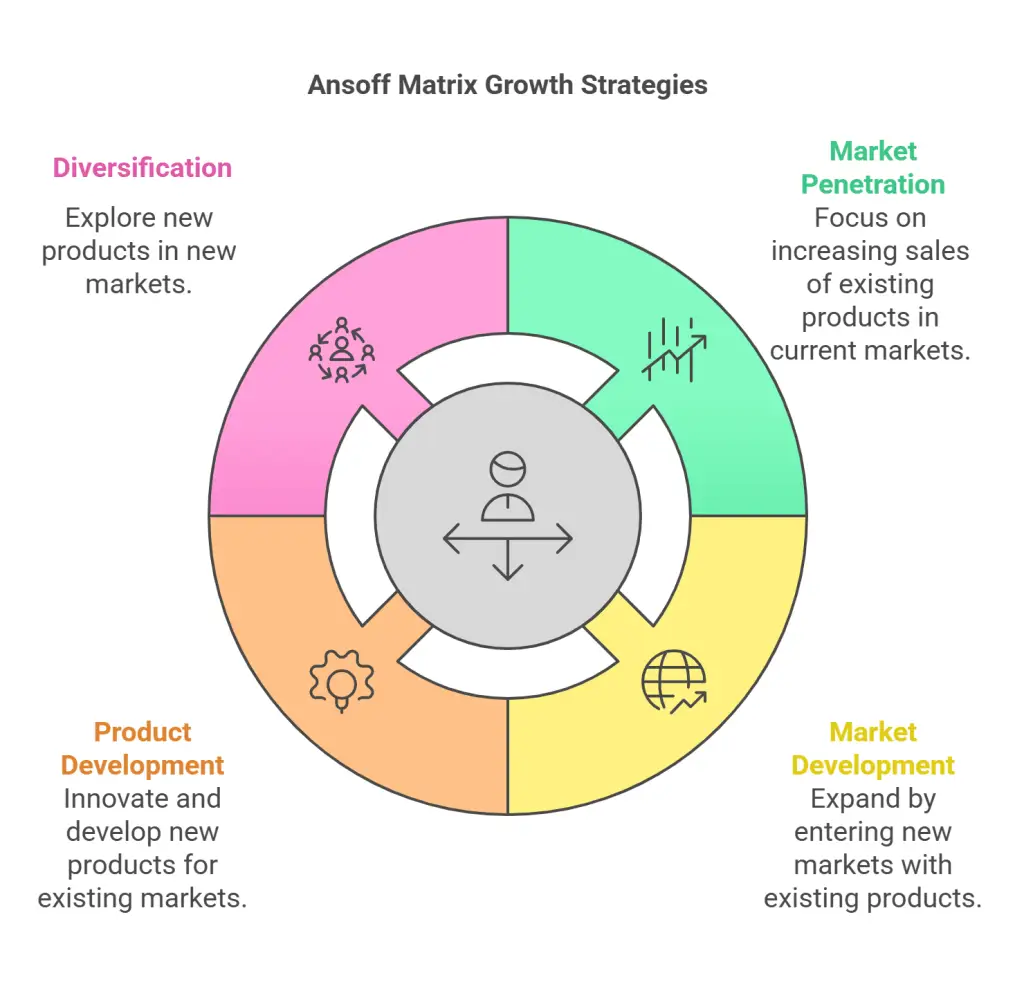As a small business owner, you’re constantly faced with decisions that shape the future of your company. Whether you’re trying to understand your market, identify your competitive edge, or plan for growth, having a clear strategy is crucial. But how do you build a strategy that’s both comprehensive and flexible enough to adapt to the ever-changing business landscape? The answer lies in using business strategy frameworks.
Business strategy frameworks are tools that help you analyze your business environment, assess your company’s strengths and weaknesses, and chart a course for growth. These frameworks provide a structured approach to problem-solving, ensuring that you consider all the relevant factors before making decisions. In this post, we’ll explore the top 10 business strategy frameworks that are particularly useful for small businesses. We’ll discuss how each framework works, its benefits, and how you can apply it to your business.
1. SWOT Analysis: Strengths, Weaknesses, Opportunities, Threats
SWOT Analysis is one of the most widely used business strategy frameworks, especially for small businesses. It involves analysing your company’s internal strengths and weaknesses, as well as external opportunities and threats. By doing so, you can gain a comprehensive understanding of where your business stands and how you can leverage your strengths to take advantage of opportunities while mitigating risks associated with weaknesses and threats.
How to Use It:
- Strengths: Identify what your business does well. This could be anything from a strong brand, loyal customer base, unique technology, or any other factor that gives you an advantage.
- Weaknesses: Acknowledge areas where your business needs improvement. These could include factors like limited resources, lack of expertise, or operational inefficiencies.
- Opportunities: Look at external factors that you could exploit to grow your business. These could be new markets, technological advancements, or changes in consumer behavior.
- Threats: Identify external challenges that could negatively impact your business, such as new competitors, changing regulations, or economic downturns.

Benefits: SWOT Analysis is simple to use and can be applied at any stage of business development. It’s an excellent tool for identifying both immediate and long-term strategic actions.
2. PESTLE Analysis: Political, Economic, Social, Technological, Legal, Environmental
PESTLE Analysis is a framework used to analyze the macro-environmental factors that could impact your business. This tool helps you understand the broader forces at play in your industry and how they might affect your business operations.
How to Use It:
- Political: Examine how government policies, regulations, and political stability might influence your business.
- Economic: Consider economic factors such as inflation, interest rates, economic growth, and exchange rates that could impact your business.
- Social: Analyze societal trends, including demographics, lifestyle changes, and consumer behavior that might affect demand for your products or services.
- Technological: Assess the impact of technological innovations and changes in your industry.
- Legal: Review any legal requirements or regulations that might affect your business operations.
- Environmental: Consider environmental factors such as climate change, sustainability trends, and ecological regulations.

Benefits: PESTLE Analysis is particularly useful for strategic planning and risk management. It helps you anticipate potential challenges and opportunities in the external environment, allowing you to adjust your strategy accordingly.
3. Porter’s Five Forces Model
Developed by Michael Porter, this framework helps you analyze the competitive forces within your industry. By understanding these forces, you can identify the intensity of competition and the profitability of your market.
How to Use It:
- Competitive Rivalry: Assess the level of competition among existing players in your market. High competition usually means lower profitability.
- Threat of New Entrants: Consider how easy it is for new businesses to enter your market and compete with you.
- Bargaining Power of Suppliers: Evaluate how much power your suppliers have to drive up prices or reduce quality.
- Bargaining Power of Customers: Analyze how much power your customers have to drive prices down or demand better services/products.
- Threat of Substitutes: Consider the likelihood of customers finding a different way to meet their needs that doesn’t involve your product or service.

Benefits: Porter’s Five Forces Model is invaluable for understanding the dynamics of your industry. It helps you identify where your business stands in relation to competitors and how you can position yourself to maximize profitability.
4. The Balanced Scorecard Approach
The Balanced Scorecard is a strategic management tool that allows businesses to monitor and measure their performance across four key areas: Financial, Customer, Internal Processes, and Learning & Growth. It provides a more holistic view of business performance beyond traditional financial metrics.
How to Use It:
- Financial: Track financial performance using metrics like revenue growth, profit margins, and return on investment.
- Customer: Measure customer satisfaction, retention, and market share.
- Internal Processes: Evaluate the efficiency and effectiveness of your business processes.
- Learning & Growth: Assess your business’s ability to innovate, improve, and grow over time.

Benefits: The Balanced Scorecard ensures that your business strategy is well-rounded and focused on long-term sustainability. It helps align business activities with the company’s vision and strategy while improving internal and external communication.
5. Lean Startup Methodology
The Lean Startup Methodology is a framework that emphasizes rapid experimentation, customer feedback, and iterative product development. It’s particularly useful for small businesses and startups looking to validate their business ideas quickly and efficiently.
How to Use It:
- Build: Create a minimum viable product (MVP) that addresses your customers’ most critical needs.
- Measure: Collect data and feedback from customers on the MVP.
- Learn: Use the feedback to refine your product or pivot to a new strategy if necessary.

Benefits: The Lean Startup Methodology helps minimize waste and reduce the risk of failure by focusing on developing products that meet real customer needs. It allows businesses to adapt quickly to changes in the market.
6. The Blue Ocean Strategy
The Blue Ocean Strategy is a framework that encourages businesses to create new, uncontested market space (a “Blue Ocean”) rather than competing in overcrowded industries (a “Red Ocean”). This involves finding innovative ways to deliver value to customers, creating a new demand.
How to Use It:
- Value Innovation: Focus on both differentiation and low cost to unlock a new market space.
- Reconstruction: Break away from traditional industry boundaries and redefine the market by creating a new value proposition.

Benefits: The Blue Ocean Strategy is powerful for small businesses looking to differentiate themselves and avoid direct competition. It encourages innovation and opens up new growth opportunities.
7. The Ansoff Matrix
The Ansoff Matrix is a strategic planning tool that helps businesses determine their growth strategy. It focuses on four key areas: Market Penetration, Market Development, Product Development, and Diversification.
How to Use It:
- Market Penetration: Focus on increasing sales of existing products in your current market.
- Market Development: Expand your business by entering new markets with your existing products.
- Product Development: Innovate and develop new products for your existing market.
- Diversification: Explore new products in new markets.

Benefits: The Ansoff Matrix is ideal for businesses looking to grow and diversify their revenue streams. It provides a clear framework for evaluating the risks and benefits of different growth strategies.
8. Business Model Canvas
The Business Model Canvas is a strategic management tool that allows businesses to describe, design, and analyze their business model. It’s a one-page template that covers all the key components of a business, from value propositions to customer segments.
How to Use It:
- Value Propositions: Define the unique value your business offers to customers.
- Customer Segments: Identify and understand your target market.
- Channels: Determine the channels through which you will deliver your value proposition.
- Customer Relationships: Define the type of relationship you want to build with your customers.
- Revenue Streams: Identify how your business will make money.
- Key Resources: Determine the resources needed to deliver your value proposition.
- Key Activities: Identify the critical activities necessary for your business model.
- Key Partnerships: Determine which partners and suppliers you need to create and deliver value.
- Cost Structure: Understand the costs associated with your business model.

Benefits: The Business Model Canvas is an excellent tool for small businesses to visualize and refine their business model. It’s particularly useful for startups and businesses in the early stages of development.
9. BCG Matrix: Growth-Share Analysis
The BCG Matrix, developed by the Boston Consulting Group, is a portfolio management tool that helps businesses evaluate their products or business units based on their market growth rate and relative market share. It divides products into four categories: Stars, Cash Cows, Question Marks, and Dogs.
How to Use It:
- Stars: High market share and high growth. These are your leading products that require investment to maintain their position.
- Cash Cows: High market share and low growth. These are your stable products that generate consistent cash flow.
- Question Marks: Low market share and high growth. These products require careful consideration; they could become Stars or fail.
- Dogs: Low market share and low growth. These products may need to be discontinued or repositioned.
Benefits: The BCG Matrix is useful for small businesses with multiple products or services. It helps you allocate resources effectively and make strategic decisions about where to invest or divest.
10. Choosing the Right Framework for Your Business
With so many business strategy frameworks available, how do you choose the right one for your small business? The answer depends on your specific needs, goals, and the stage of your business. Here’s a guide to help you decide:
- Early-Stage Businesses: If you’re just starting out, frameworks like the Lean Startup Methodology and Business Model Canvas are ideal. They help you quickly validate your business idea and develop a robust business model.
- Growth-Oriented Businesses: For businesses focused on growth, the Ansoff Matrix and Blue Ocean Strategy are valuable. These frameworks help you explore new markets and innovate in ways that set you apart from competitors.
- Established Businesses: If you have an established business, SWOT Analysis, PESTLE Analysis, and Porter’s Five Forces Model can help you assess your position in the market and refine your strategy for sustained success.
- Portfolio Management: If you have multiple products or business units, the BCG Matrix is an excellent tool for managing your portfolio and making strategic investment decisions.
- Balanced Performance: For businesses looking to improve overall performance, the Balanced Scorecard provides a comprehensive view of your operations, ensuring that all aspects of your business are aligned with your strategic goals.

Conclusion
Business strategy frameworks are essential tools for small businesses looking to thrive in today’s competitive environment. Whether you’re just starting out or have been in business for years, these frameworks offer structured approaches to analyzing your market, refining your strategy, and achieving your business goals. The key is to choose the right framework for your specific needs and to apply it consistently as part of your strategic planning process.
By using these frameworks, you can gain a deeper understanding of your business environment, identify new growth opportunities, and make more informed decisions. As you apply these tools, remember that the best strategies are those that are adaptable and evolve as your business and market conditions change.
Further reading
ClearPoint Strategy. “16 Strategic Planning Models To Consider.” ClearPoint Strategy Blog. Accessed January 31, 2025. https://www.clearpointstrategy.com/blog/strategic-planning-models.
Asana. “11 Strategic Planning Models and Frameworks.” Asana Resources. Accessed January 31, 2025. https://asana.com/resources/strategic-planning-models.
The Strategy Institute. “Top 5 Strategy Frameworks Every Business Strategist Must Know.” The Strategy Institute Insights. Accessed January 31, 2025. https://www.thestrategyinstitute.org/insights/top-5-strategy-frameworks-every-business-strategist-must-know







